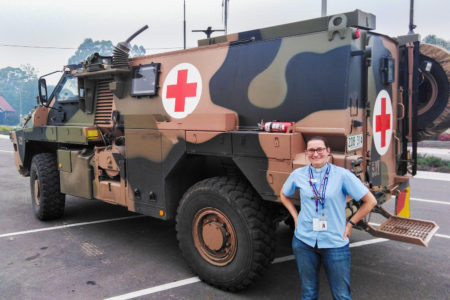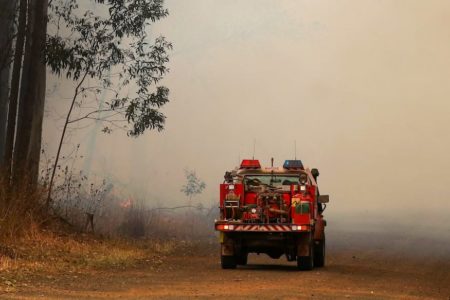This time last year all we could talk about was the devastating effects brought about by something beyond our control. No, it wasn’t COVID, it was the bushfires. 12 months later, much of East Gippsland is still on its knees.
By Mikaela Turner
Never has the world looked forward to New Year’s Day as it has this year. The desire to strike 2020 off the calendar and jettison it out of our collective consciousness grows stronger as we tick off each remaining day.
But, while 2021 may not bring distress and abject despair on the scale this year has, it would be folly to think we will be able to simply dust ourselves off on January 1 and get back to what we once knew as normal.
Furthermore, it would be calamitous to do so. COVID-19 has caused so much horror and heartache, it has consumed us so completely and overtaken our lives to such an extent that we all are suffering, individually and collectively, from memory loss. That is, it is difficult to remember a time when COVID wasn’t part of our everyday life. And, just as importantly, it’s difficult to remember our life pre-COVID.
This last point has particular significance for East Gippsland. Think back to this time last year. Then, as now, the news was monopolised by a singular topic. As Australians, and, in particular, Victorians, we were united in grief by an event beyond our control. It was an event that was instantly devastating and destructive and its effects would be felt for years to come.
But it wasn’t COVID. It was the bushfires.
Remember them? Remember those images of the blood red skies that served as a canopy of death? In Mallacoota, for example, those photographs that so graphically illustrated the terror experienced were taken on December 29. It’s almost 12 months to the day.
More than 30 people died in the fires, which is a long way short of the 900-plus people who have lost their lives in Victoria to COVID, but more than 3000 people lost their homes and several townships now resemble ghost towns. Those homes and towns were relying on us, people living elsewhere, to rescue them with our manpower and tourist dollars. But COVID brought a quick halt to that.
Crosslight ventured back to East Gippsland in October to see and hear first hand what the twin terrors of bushfires and COVID have wreaked upon it. What we discovered were tales of heartbreak and hopelessness, but also resilience and hope. Disaster has always brought out the best in us – we have always rallied around in each other in times of need – but that was difficult at best, impossible at worst this year.
The people of East Gippsland are not unaccustomed to grief, but they were wholly unprepared for what 2020 had in store for them.
The first signs of fire sprang rapidly into view in November 2019 and it would take three months – until February 27, to be exact – for them all to be contained.
A month earlier, on January 25, Australia recorded its first case of the COVID-19 virus. No one paid it much mind at the time, but two months later, on March 28, Victoria was headed into its first lockdown.
At the time of writing, the state is just emerging from the longest and tightest lockdown it has ever experienced – eight months.
Every Victorian – particularly those in metropolitan areas – has felt the frustration and fear the isolating effects of these lockdowns have wrought. We have all missed our family and friends, among many other things, as we’ve been confined to our homes.
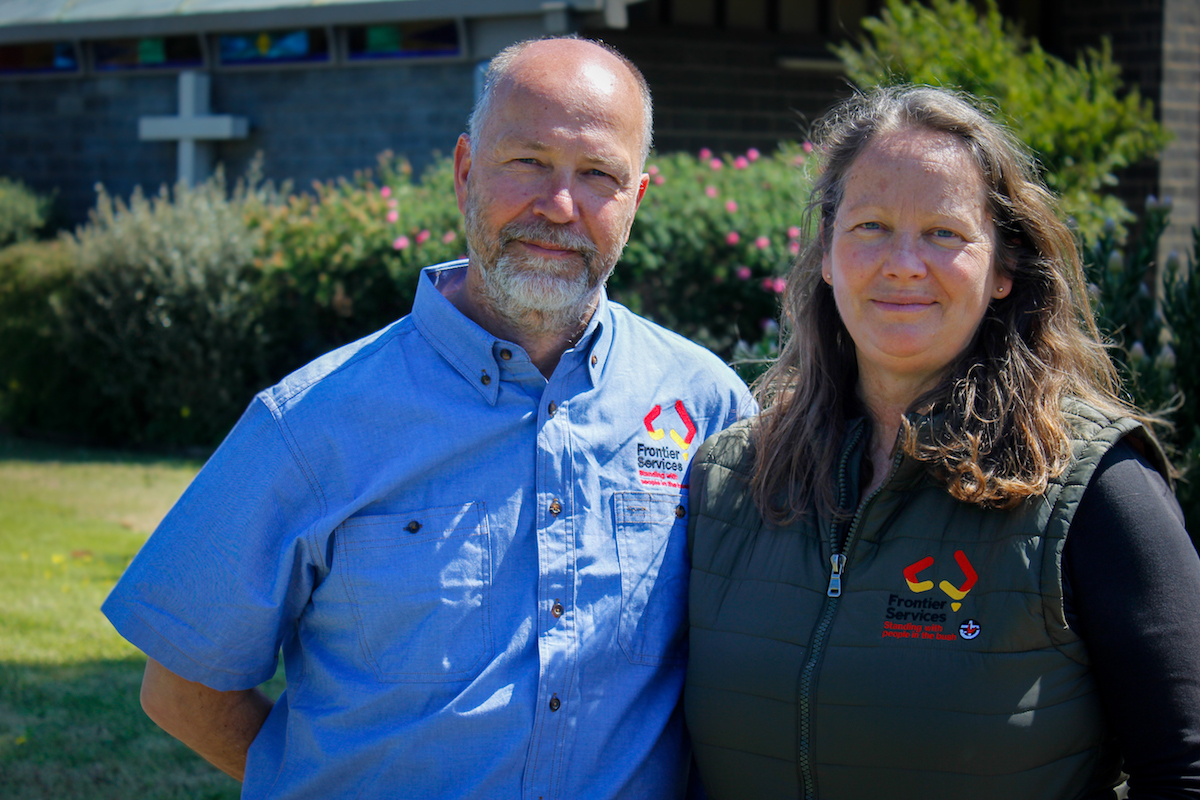
Gippsland presbytery ministers Rev Arnie Wierenga and Rev Jennie Gordon.
Many have railed against the enforced restrictions, but more have silently and steadfastly heeded the government’s instructions. That’s what we do in times of crisis – we think of the collective good and act accordingly.
One thing almost all of us have had, however – and this been regrettably under appreciated – is a place to call home. We have all despaired at times at having to “stay home” but what we haven’t done is appreciate the fact we have a home to be confined to.
In East Gippsland, there are still more than 1000 people from more than 400 households who don’t have a home.
Many lives have been changed, some possibly irreversibly. Rev Jennie Gordon wrote an extensive article in the April edition of Crosslight that was at once heartbreaking and heartwarming. The devastation brought to bear on East Gippsland was laid bare, but as she walked through the ruins and spoke to those affected, she reminded us to hold on to our faith. Hold on to hope.
“Death and resurrection are intrinsic to our faith,” she wrote.
Jennie laid out a map to recovery and she urged those of us living elsewhere to help. Help by taking the time to journey to East Gippsland, even plan a stay. Our presence and our money would help the healing process
In retrospect, it seems naive, but we weren’t to know any better back then. COVID-19 hadn’t bared its teeth yet.
“When we are no longer on high COVID-19 alert, visit and worship with the local folk,” Jennie wrote.
“Stay, spend money in the towns and support the small businesses. Plan a church camp at our park at Lake Tyers. In six months, as winter opens into spring, ask what you can do to help. If you have skills, gifts and graces in chaplaincy or pastoral care to offer, for a short or longer time, contact the Gippsland or North East Presbyteries.
“Our world has been fundamentally changed by this horrendous bushfire season. Now is the time, more than ever before, to take off our shoes, stop stomping over this fragile, ancient earth and tread lightly, live lightly, love greatly. All of us are bushfire affected.”
That was then. April.
Jennie’s life and that of her husband, Rev Arnie Wierenga, has not panned out as planned in the intervening months. But they’re not complaining. In fact they are thankful for the work they have been asked to do. Happy in the fact they have been a source of help.
Jennie and Arnie’s regular “day jobs” are Gippsland presbytery ministers, but for the past few months they’ve also become bushfire recovery chaplains, something they fell into.
Originally, the plan was to hire a full-time chaplain, but when COVID-19 arrived it became too difficult to interview people and get funding in place.
“Links we might have made have been put on hold,” Arnie says. “Inhabiting the bushfire recovery role as well as doing our presbytery work isn’t ideal, but we figured we needed something on the ground, so even though there are a lot of demands on our time, at least something is happening there.”
What started as a fill-in role until a new bushfire chaplain could be hired, has become Arnie and Jennie’s “world” this year. But it’s been an experience they’ve treasured.
“I think secretly we’d love to do it full time,” Arnie says.
The couple has walked alongside bushfire-affected communities all year and seen the best and the worst of it. They’ve witnessed the “incredible resilience” of farming communities, such as those around Swifts Creek, where Jennie says people “simply deal”.
“They deal with drought all the time, so fire and COVID-19 are just one of those things, they’ll pass and then there’ll be another season of something,” she says.
They have also witnessed people waiting months for support only for it to be endlessly delayed.
“One 70-year-old man in Mallacoota pushed a relocatable house into position with some of his friends because he’d been waiting five months for someone from Melbourne to come and do it and just got fed up,” Arnie says.
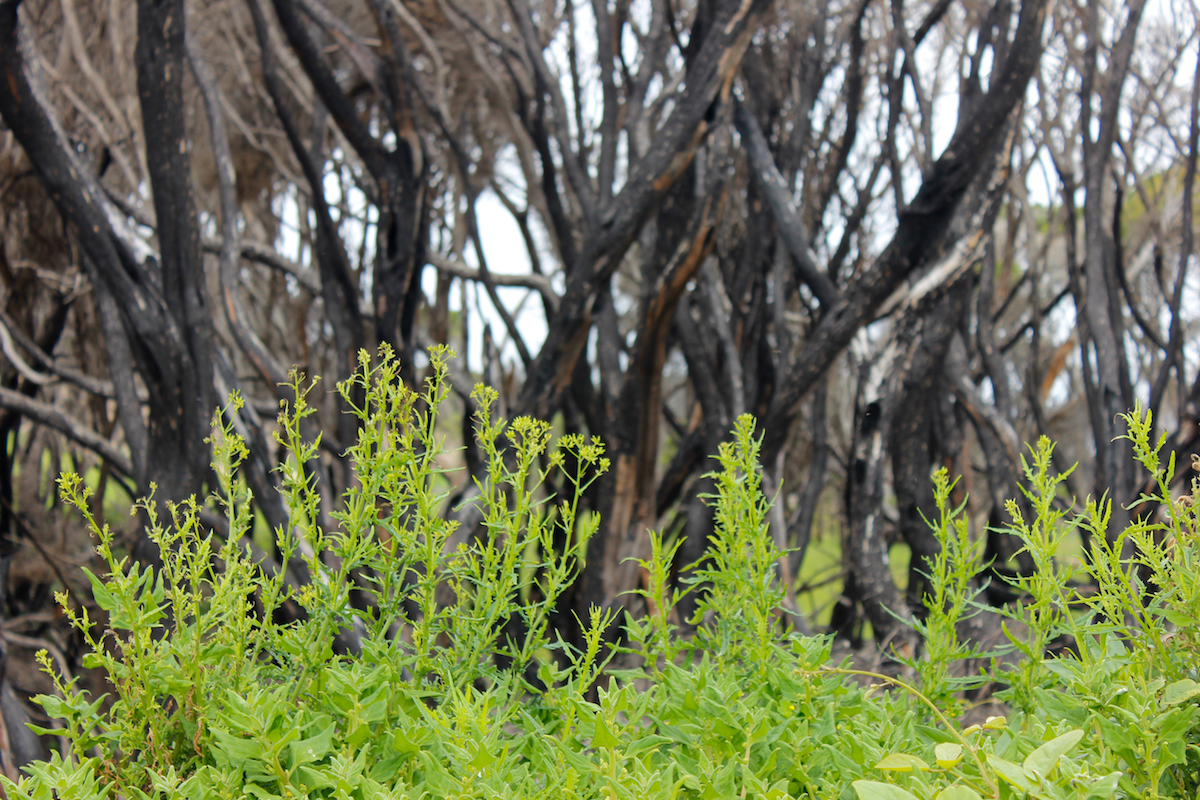
“They deal with drought all the time, so fire and COVID-19 are just one of those things, they’ll pass and then there’ll be another thing,” Jennie says.
Their ultimate goal in this role is to build connections. But in a year where connections are few and far between, it’s been a challenge.
“During the first year, the focus is to build relationships,” Jennie says, “but we don’t have the capacity to take that long in the space because people needed someone to be there straight away. “There is a sense of urgency, so the lack of capacity to be there due to restrictions is very frustrating.”
This separation is something local ministers are also feeling profoundly. In a lot of ways, they’ve had to relearn how to do their jobs.
“A lot of ministers come out of college, get their first placement and find their rhythm,” Jennie says. “They know how to work and how to get in the zone, but that rhythm has been disrupted for everyone.
“Ministers who’ve been in placement for years or ministers in their first placement, we’ve lost our rhythm and the constant stress of having to rethink everything we do, the way we deliver it, how we care for people, it’s just exhausting.”
Arnie adds: “I feel there’s a cumulative weariness that comes with the nature of keeping track of everything. Because of the nature of our role, we need to be COVID experts and it’s hard keeping up with that.”
This sense of weariness extends far beyond ministry roles, Jennie and Arnie explain. In little country towns, especially those who were fire-affected, they haven’t been able to take a holiday, to have a break.
“Usually they would have a big summer season and then take a couple of weeks off between seasons,” Jennie says. “But they haven’t had those breaks because they never had their big summer season. They’ve had massive trauma, they’ve been isolated and now they’re exhausted.”
BAIRNSDALE
Bairnsdale is the big city of East Gippsland. It has everything – a hospital, the big three supermarkets, Bunnings, sports clubs and a surprising amount of traffic lights. And importantly, it has something East Gippslanders are searching for more than ever: safety.
During the fires, which were dubbed “Black Summer”, Bairnsdale became a refuge for many fleeing them. And after the last ember was extinguished, a lot of people chose to stay.
Rachel, who requested her name be changed for this article, is one of them. After her Sarsfield house burnt down, she knew she couldn’t go back. The possibility that it might happen again was just too much to bear.
“Any type of fire sets me off now, even candles,” she says. “The fear of it is horrendous, but I know I’m safe now, I’m in Bairnsdale, it would be very unlikely to hit here.”
Once you understand what Rachel has been through, it’s easy to see why she’d rather leave her community. She lost everything, the house she “adored” burnt to the ground along with everything in it. And without any insurance, “everything” truly means everything.
To make matters worse, for three-and-a-half months after the fires Rachel woke up every day faced with the ghost of her former home. She’d moved in with her sister, whose house sits just down the hill from Rachel’s old one. So, just when Rachel thought she was starting to forget and to move on, she’d look out the window and see that empty lot and the memories would come flooding back.
“Looking at it every day was really hard, even traumatising,” she says.
Finding a new place to live was a combination of exhausting, challenging and frustrating. “Rent went up dramatically overnight and accommodation was scarce,” she says. “(All that was on offer was) somewhere I really wouldn’t want to live, I couldn’t even afford, it was that bad.”
Thankfully, Rachel wasn’t alone. Her son stepped in and bought a house in Bairnsdale she now rents from him. It was a great first step, but a house is more than four walls and a roof. It requires things – furniture, pots and pans, bedding.
“Replacing absolutely everything, you can’t understand what that’s like,” Rachel says. “To this day I’ll be rummaging through my wardrobe looking through for something thinking ‘where has that gone?’ and then all of the sudden it hits me – it burned.
“The suitcase I packed when I evacuated was only summer clothes, I had no winter clothes. I lost a lot of my childhood photos, I remember thinking I should go back and get more but you don’t believe it’s actually going to happen, for one, and the suitcase was already so full, I thought I can’t fit another thing in.
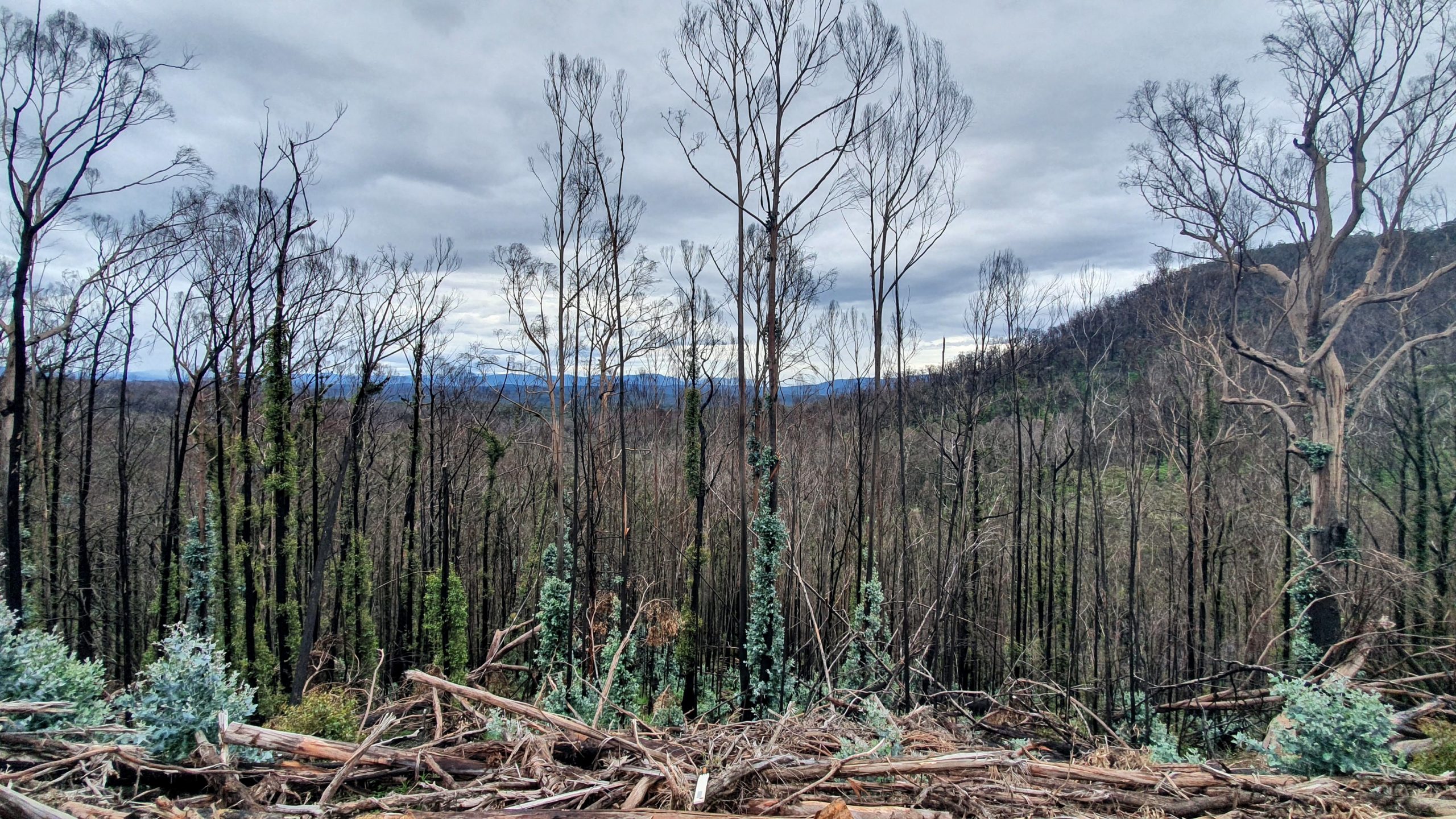
“Replacing absolutely everything, you can’t understand what that’s like,” Rachel says.
“I ended up with that one suitcase, a dog and a 20-year-old car.”
But again, Rachel wasn’t alone. “The community has been unbelievable,” she says. “How people have helped, I hope I spend the rest of my life doing for them, to thank them.”
Rachel has already started giving back. She’s volunteering at both Bairnsdale Uniting Church’s op shop and the Anglican op shop. It’s here she’s witnessed just how giving the community can be.
Once during a shift Rachel made a passing comment to a colleague about liking a cabinet the op shop was selling. When inevitably customers came in wanting to buy that very cabinet, her colleague told them Rachel’s story. Without hesitation, the customers bought the cabinet for Rachel. “Give it to her, we’ll pay for it,” they said. Simple as that.
“Whether you’d lost your home or not there was just this incredible sadness and everyone helping each other,” Rachel says. “As bad as it was, it was wonderful to live through human nature being so good. That makes a huge difference.”
NICHOLSON
The small suburb of Nicholson lies nestled between Sarsfield and Bairnsdale. Depending on which end you’ve come from, your driving experience will be completely different. From one end, the “Sarsfield end”, evidence of bushfire is everywhere. But from Bairnsdale, it’s nowhere.
Val Kinghorn, 86, has lived in her storybook cottage home for the past 25 years. She’s spent those years, alongside her husband, tending to a lush garden which surrounds the house, full of fruit trees and sweet-smelling flowers. She created this garden for her own pleasure, as a hobby. Yet, she never could have imagined this very garden would save her house.
On December 30 last year, Val was with her husband, Walter, in hospital in Bairnsdale. He’d fallen ill just after Christmas. She didn’t evacuate, didn’t pack her things, didn’t really grasp what was on its way. She simply went to be with her husband for his evening meal. It wasn’t until she tried to leave the hospital and was stopped by a security guard that she realised anything was wrong. The guard had asked where she lived and upon hearing her answer said matter-of-factly “you’re not going home”.
“When I was driving to the hospital it looked so clear,” Val says. “It all happened very quickly, I was just in the clothes I had on.”
Meanwhile, back in Nicholson, Val’s son and grandson were on the job. They’d spent hours drenching Val’s garden, filling the gutters with water and blocking them with homegrown lemons and grapefruits. They had pumps, which circumnavigate the house, going all day. Something Walter would say was “a waste of water”. But it wasn’t.
The next day, Val’s daughter Vicki went to the house bracing for the worst. But it never came. It was bad, for sure, but not the worst. They’d lost sheds, tractors, horse floats and a caravan, but the house was still standing. Its surrounding garden still wet.
But there was no time for relief. Walter was continuing to deteriorate. And on January 22, less than a month after the fire, the 94-year-old passed away.
If you’ve lost someone, you’ll understand how difficult it is to plan a funeral. How much you wish you could just stop and process and mourn, but can’t. If you’ve lost property to fire, you’ll understand how stressful it is. To organise your insurance, to get power and water back, to have the debris cleaned up and fences rebuilt. Now, combine the two.
“It’s heartbreaking and it’s going to take a long time to reorganise our lives,” Vicki says. “We’re lucky to have a home, but everything else is gone, including many of Dad’s prized possessions. Even though we are in October we are still working through it all, it’s not an instant thing, where everything can be recollected. It’s been just surviving, really.”
Vicki moved in with Val after the fires and says they’ve become quite “insular” this year for two reasons. The first one is unsurprising: COVID-19.
“We absolutely feel forgotten,” Vicky says. “By April, people were just all over COVID-19, but we were still struggling from the fires, trying to piece things back together.
“That was all swept away because people would think ‘the fires were months ago, you’re over that’. Yes, COVID-19 was unprecedented, but so were these fires, their enormity is hard to grasp.”
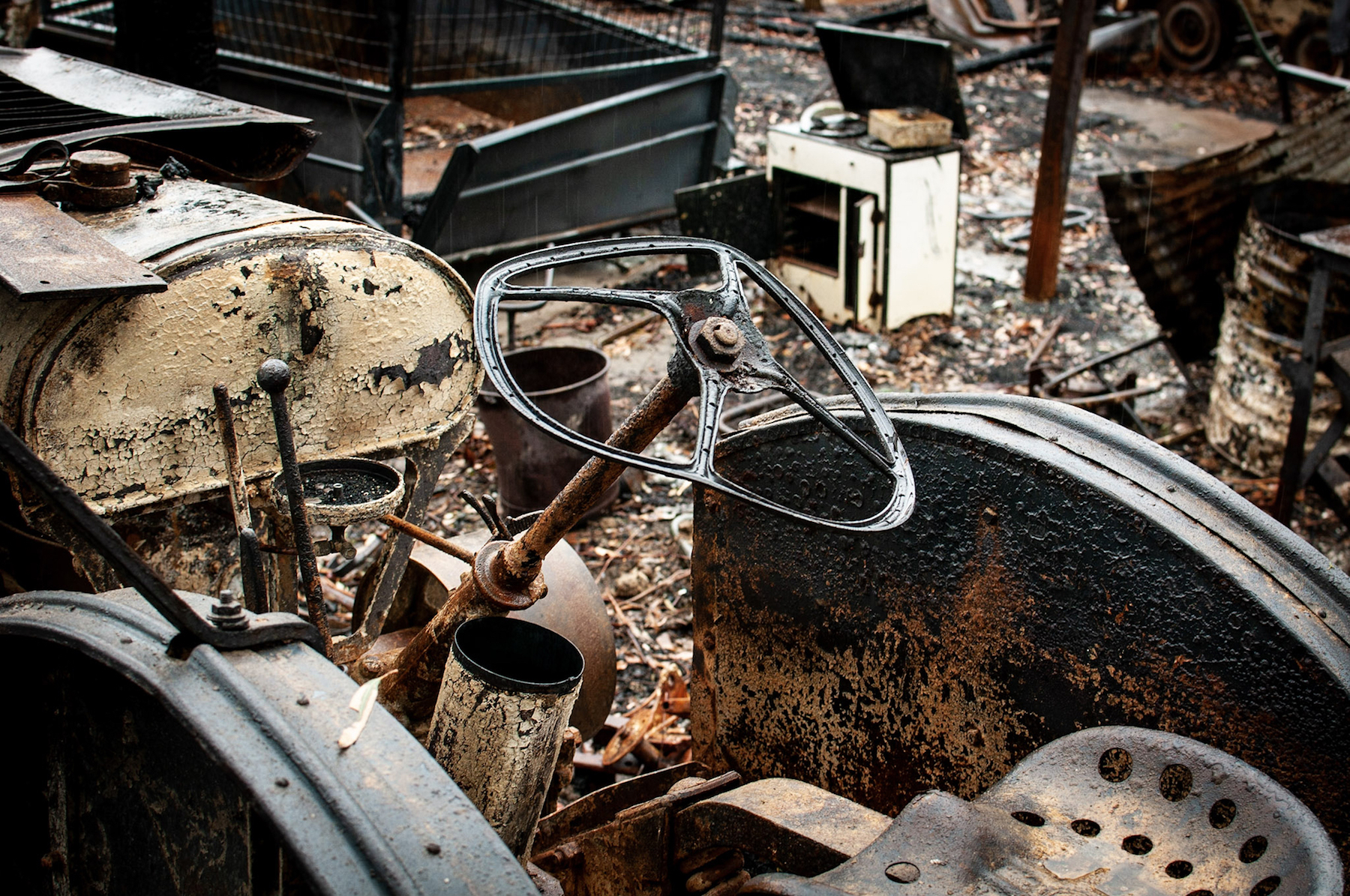
Val’s husband’s tractor was destroyed in the fire. Photo: Ian Ferguson
The second reason was commonly cited throughout all of East Gippsland, yet still a surprise: lack of understanding – a divide between those who lost their house and those who didn’t.
For Vicki and Val, people, even family members, could not understand their trauma. They’d think ‘you have your house, you’re fine.’ But they weren’t fine, they’re not fine. Fine is still a while off.
“The first fire I lit, to dispose of some hedge that had been ripped out, I was scared stiff,” Vicki says. “I lit one pile and was just shaking, I was really messed up. It’s taken a huge toll. Even just having the debris and security fencing here until July, it’s very imposing and uncomfortable to live with.
“I’ve had ongoing counselling because I’ve felt I needed it, I fell apart. A lot of that was because of the isolation you’re put into because of the whole ‘you didn’t lose your house, get over it’, but it’s still trauma.”
BUCHAN
At the foothills of the Snowy Mountains sits this picturesque town. While small in size, Buchan is big in beauty. Narrow roads wind between lush-green paddocks leading you into the main street, where the town’s roadhouse, cafe, pub and post office reside.
Despite hosting a population of about 300, Buchan is well-known. Its spectacular limestone caves attract thousands of visitors each year. Except 2020. This year, the caves have been closed.
If you venture into the Buchan Caves Camp and Caravan Park, at first glance, it’s beautiful. You’ll travel over two little bridges, crossing crystal clear streams to make it to the reception centre – an old brick building with a warm, cosy feel to it. The whole scene is inviting, like something out of a fairy tale.
But zoom out a little and you will realise the hills surrounding the park are topped with burnt trees. Follow the signs leading to the cabins and you’ll be met with an imposing construction fence. Peer through that fence and you’ll see signs pointing to cabin No.1 car park. But where is cabin No.1? All that remains is a patch of grass and a gravel driveway. Cabin No.1 is gone, burnt down, along with the other cabins.
One of the caves, The Royal Cave, is looking quite well. Its stone entrance stands tall and proud. But the same cannot be said for its companion. The Fairy Caves is hiding behind more construction fences. It’s heritage-listed entrance has been reduced to rubble.
If the fire came here, just a 15-minute walk from the centre of town, where else did it go?
Marg Brick has one answer: it went to her house. Her property of almost 20 years was “obliterated”. Her family home was left with only a front fence, netball ring and trampoline.
It’s not the first time she has lost property to fire. Marg and her husband, Greg, are the owners of the local pub, the Buchan Caves Hotel. And in 2014, the beloved pub burnt to the ground due to a structural fire. But after an astounding crowd-funding effort, which brought in about $600,000 in donations from as far as Scotland to New York, they were able to rebuild.
So when Marg stood at the back of the pub on the evening of December 30, 2019 and watched a fire start to crest over the hill heading towards her, you can understand why she’d be thinking ‘not again’.
But then she heard a sound, a big jet plane. She thought “thank god, we’re getting water bombed” but there was no plane, no water-bombing. Help came from mother nature herself. The sound was the wind changing.
“I’ve heard that happens, but I hadn’t experienced it before, it honestly sounds like a huge jet because it sucks up all the air,” she says.
“It was about to hit us, but then it just went straight up the side of the hill, it was like ‘what, where did it go?’. Next minute, we just had a tiny bit of grass burn, but it never came down the hill, it was amazing.”
In this moment, Marg had no idea her house had already gone. She also had no idea the wind change that saved her pub would drive the fire towards three houses at the end of the street, houses that wouldn’t survive the night.
About 28 houses in Buchan were lost that night, along with one life – the only Victorian life lost in the fires.
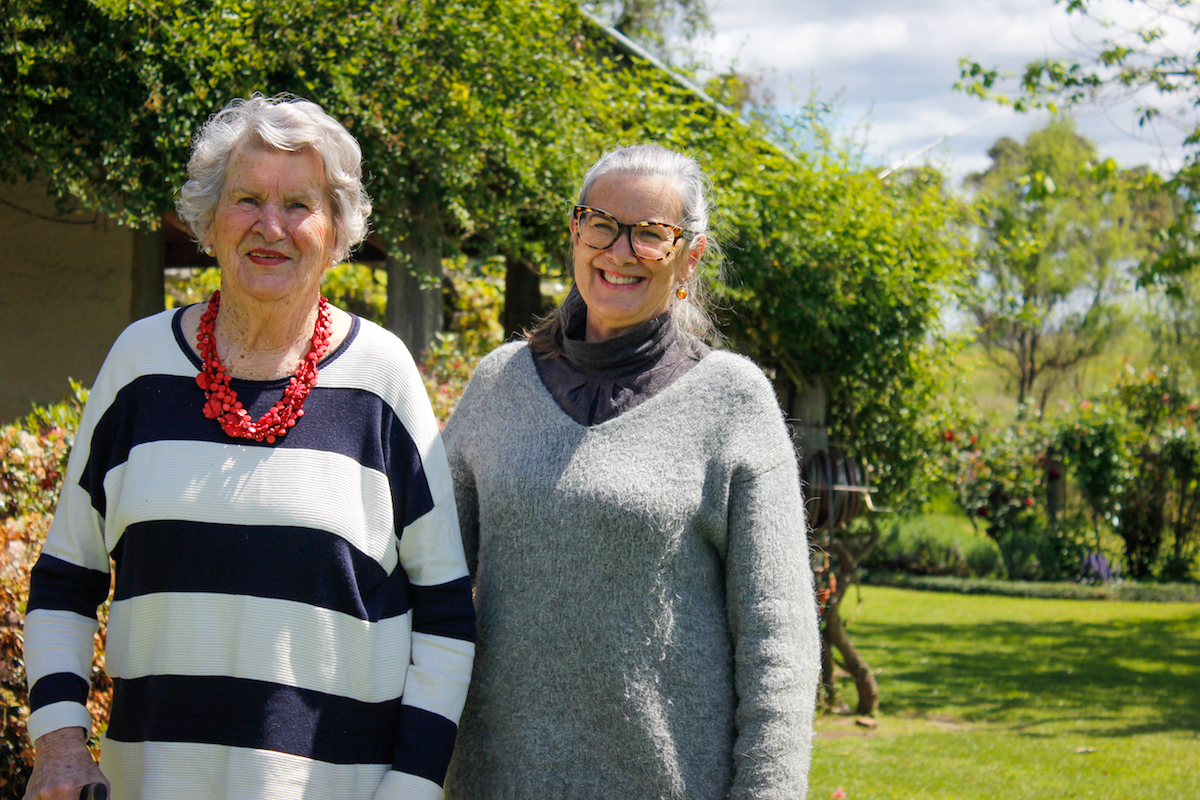
Val Kinghorn and her daughter Vicki Spencer.
When a town goes through something like this, you hope it will develop a sense of solidarity, closeness, support. But hope isn’t always enough.
“Community-based fire recovery just doesn’t work,” Marg says. “Everyone was hit differently so it became a bit of ‘did you lose your house or not?’, it almost became a bit of fire-envy.
“Once I found out our house had burnt down, I thought ‘oh thank God, no one can point to us and say well, you’re OK’. It’s crazy to say, but it was easier to be in the burnt category.”
Making that category meant you got financial support, $40,000 from Red Cross, Marg says. It also meant you had visits from a Royal Flying Doctors Service psychiatrist, checking up to make sure you were doing OK. And importantly, it meant you didn’t have people saying you had no right to your own trauma.
But that’s not to say rebuilding is easy. It’s a long, long way from easy. And frustratingly, it’s only been made harder due to something we all dread – red tape.
It started immediately after the fire. People started receiving water bills. Bills for water they used fighting the fire. “They had no idea they were paying for their water to fight the fires and there’s still people with those bills,” Marg says.
Then plans started going to the council for rebuilding. People were told they couldn’t rebuild where their house was before. One man was told he’d need to cut down two trees to allow a truck to get the modular housing he’d ordered to his property. Those two trees would cost him $60,000. “We just lost how many millions of trees and yet they want to charge that much?” Marg says.
Marg and Greg had plans drawn for a new house in March. By June, they’d been submitted to the council. Immediately, problems appeared. They were told their shed had to be 200m from the road and suggested they build it on a limestone hill.
“But “you can’t build on limestone”, Marg says.
Then the council started fighting over where the road is. “They’ve drawn the map wrong, if they came and had a look, they’d see,” Marg says. “We were promised by the Victorian government there wouldn’t be any red tape, but it is there and it’s shocking.”
So far, just one family has had their rebuilding plans approved.
Then came the BAL ratings, Bushfire Alert Level. Marg and Greg were told originally they weren’t going to get one and without it, you can’t build. “The house has been there since 1960, you can’t do that to people,” Marg says.
So Greg pushed back. He asked them “is there a BAL rating for the national park that if you guys actually maintained would’ve meant the fire never would’ve come out of the forest?”.
It worked. In the end, they got a BAL rating of 29 – good enough to rebuild. But for now, they still await council approval. The latest plans have been in the office four weeks already, but apparently will take a further eight weeks.
“It’s disappointing,” Marg says. “We can all whinge about Dan Andrews and COVID-19 because we see him, we can see someone to blame, but with the council, who are they? Who’s got the red tape?”
COVID-19 has just exacerbated delays and community tension. “The community wasn’t getting together, the community hasn’t been together at all this year to come out and say what’s bothering them,” Marg says. “We needed to be able to voice our opinion and talk through things.”
But COVID-19 hasn’t been all bad for the couple. Marg says it “really helped” when it came to their mental health.
“When we were put into lockdown, we were actually able to sit down, have a cry and do a jigsaw or a quilt,” she says. “You could actually begin to process what happened whereas before we just didn’t have the time.”
Despite all the madness, trauma and arguments, Marg still counts herself as lucky. “While I hate living in the pub, at least I have a beautiful bed and a shower,” she says. “Our insurance was good, financially we’re doing fine, we haven’t got a house, but we’re comfortable. You just have to take those things.”
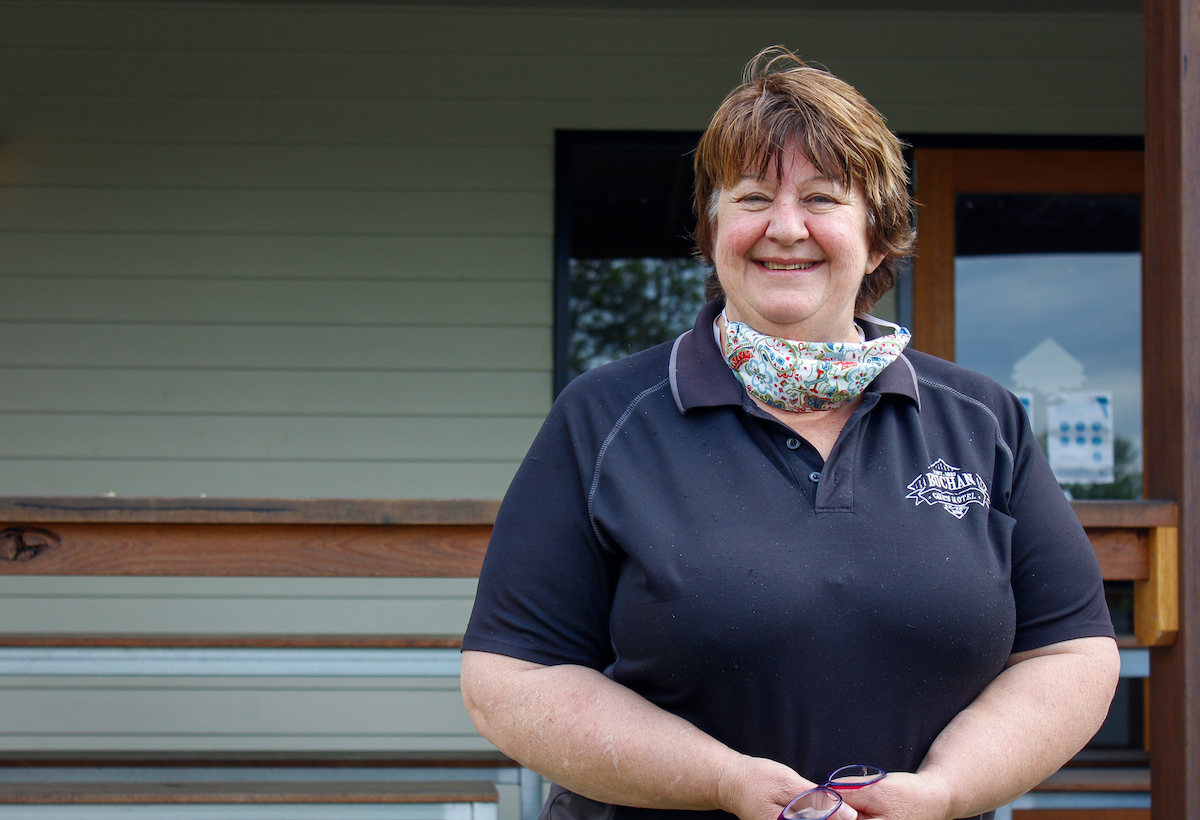
Buchan Caves Hotel owner Marg Brick.
LAKES ENTRANCE
For many Victorians this is known as a holiday town. It’s an easy-going spot with a lot to give. Canoeing, surfing, swimming, fishing, whatever water activity takes your fancy, Lakes Entrance has it. It’s no wonder the beach and lake-side town becomes host to thousands of tourists each holiday season.
Caravan parks are often booked out more than a year in advance and businesses’ annual profits are made mostly within just three months. But, last summer, bookings were cancelled, businesses were shut and people were evacuated. Then, COVID-19 arrived with its stop sign in hand – no more tourists, no more open businesses.
For Phil Loukes, Lakes Entrance is home. He was born and raised here and his businesses, Loukes Electronics, is one of the oldest in town. At 60 years of age, he has seen Lakes Entrance through it all. Or so he thought.
This year has been like no other and locals are feeling it. It’s blatantly obvious as you walk down the foreshore – usually the busiest area of town. This time last year, you would have been met with busy restaurants and boutique clothing stores. Now, it’s empty storefront after empty storefront. It’s disconcerting as a tourist. One can only imagine how difficult it is for local business owners.
“There are a lot of business that will not survive,” Phil says. “For shops that depend on holiday clientele, like motels and caravan parks, it’s been really, really tough.”
But for Phil, COVID-19 has affected more than just his town’s economy. Personally it’s halted his ability to heal because Phil is also the Lakes Entrance CFA captain. He was on the front lines during Black Summer and it was the worst fire he had seen in his 48 years on the job.
Phil’s firefighting effort began in November around W Tree, between Buchan and Gelantipy. Even then, he was already seeing “erratic fire behaviour” that he’s “probably never seen before”.
“I saw a fire travelling downhill as quickly as it was going uphill, which is not normal,” he says. “We threw all fire science out the window, we couldn’t rely on what was normal or what we’d seen before.”
But the fire was only just getting started. “It all just went crazy,” Phil says. “The day Sarsfield got hit, I had a real sense we were in a lot of trouble. The fire was out of control, there were fireballs going everywhere and trees exploding.”
While Phil was busy dealing with his own unruly fire and leading a team of up to 45 people, his daughter Bethany was fighting fires in Buchan. “I knew from radio reports it was going ballistic there as well,” he says.
Then all communication was lost. “The towers were gone, radio went down, all phone services, everything gone,” he says.
As a parent, one part of Phil was desperate to drop everything and drive straight for Bethany, but as a CFA Captain he knew his role was to stay.
“I had to put that aside, I couldn’t do anything about it so my focus had to be looking after all these people, the stuff here is all I can control,” he says.
“As captain, people look to you. Some panic because they’ve never experienced what’s coming at them and they look to you to be calm, cool and someone who can give them some steps to follow. If they’re not coping, you have to help manage them.
“That’s really hard because you know (your daughter) is going through a really tough time and you’re feeling that you could lose her.”
It was 36 hours before Phil saw Bethany again. Their reunion was quiet, a long hug and a few tears. A mutual understanding what they’d both been through that night. A unique bond forged in fire and as strong as steel.
A couple of days later, Phil could see another spike day on the horizon. A day when the weather was going to be a perfect culmination of hot, dry and windy. There were 45-50,000 people in town. It was summer after all and tourists were enjoying their holidays, many oblivious to what was happening 40 minutes away.
Phil knew he couldn’t risk all those people. He possessed information others didn’t. He’d seen firsthand just how easily fire could take this town.
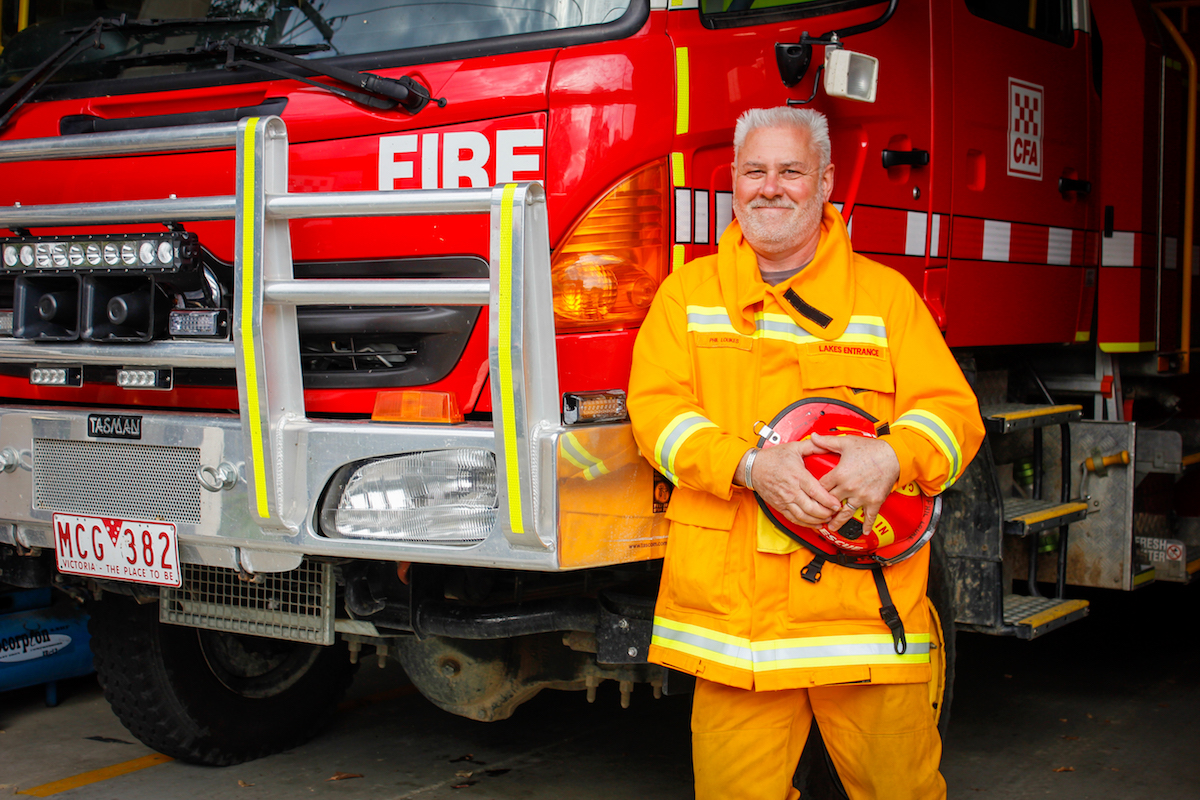
Lakes Entrance Uniting Church member and CFA Captain Phil Loukes.
Just after leaving Sarsfield, while communications were still down, he’d taken a truck to collect a strike team in Tambo Upper to relay the red flag warning – to get out. After finding them, he headed back to Bruthen to rest with his team but on the way noticed a flickering of light in his peripheral vision. A fire. It was small but Phil knew if they didn’t get to it, it would’ve been through Bruthen and into Lakes Entrance that very night. Farmers were already there with water tanks on the back of their utes trying to put it out. But with Phil’s crew on side, they put it out within an hour.
“It was incredibly lucky that crew was in Tambo Upper, if they weren’t nobody would’ve known that fire was there at all.”
This is what he was thinking of when he saw that upcoming spike day. It’s what drove him to push for evacuation. “The tourists weren’t leaving on their own,” he says. “I thought they’ve got no idea, they think they’re safe here and I can’t guarantee their protection.
“People say ‘you’re here to protect us’ but I’ll respond ‘how many houses are there in a town?’ Once it starts, it’s not possible to fully stop.”
So they had a community meeting and Phil told the thousands in attendance the story of his brother-in-law. How he thought he was safe, how he was packed and ready to leave, but was too late. How he lost his life in 2009’s Black Saturday fires.
“I told them you can’t replace people,” Phil says. “People argued ‘we’ll lose our holiday’, but I’d say ‘if you lose your life, what will you have?’.”
The next day the town went from 50,000 to 2000. “That was the best thing because it allows us in the brigade to do what we need to do and not have to worry so much about 50,000 people in town,” Phil says.
As a business owner himself and life-long local, Phil knew telling people to close up during the summer season was going to hit hard. “I knew it would decimate business,” he says.
“We have a lot of retail, tourism and hospitality businesses that rely on those peak seasons, I knew it was really going to hurt. I carried that weight delivering the message, I knew the economic cost was going to be severe and long-term.”
But remember, this was before any of us had heard of COVID-19. Before stay-at-home orders, before stage threes and fours and before streets full of “sorry we’re closed signs” were a regular sight.
If that was then, what is now? Well, now is arcades full of empty shops, and “for sale” signs in empty windows. This town needs this summer. It needs to be remembered and thought of. Because right now, it feels forgotten.
“A lot of people feel that we are old news, but we’re living a nightmare still,” Phil says. “COVID-19 has taken over and people have no certainty whether they’re going to keep their business doors open or whether they’ll fold. Others have lost everything.
“The fallout, in the economy but also with mental health, is really difficult.”
Phil has personally felt the mental health impact of isolation. Despite fighting many fires throughout his life, this one was different. Usually after a fire, he is able to reflect and heal alongside fellow members of his brigade. But this time, Zoom has been their main form of contact.
“Our brigade members were all really flat, really fatigued for a long time and then we got hit by COVID-19,” Phil says.
“We needed each other, but haven’t had the opportunity to work through things together. You build a bond and relationship with people through tough times, so COVID-19 has been a massive interrupter in terms of being able to continue in that relationship building, working and healing together, being a team.
“We’re Zooming every week, but without face-to-face it’s not the same. Sometimes you just need someone to be there, not necessarily to say anything, but just to be present. The anxiety of the fire is still haunting people and for some the impacts of major fire lasts for life.”
ORBOST
When Rev Nathaniel Atem left war-torn South Sudan for Australia, he thought he’d left fear behind. Australia was safe and certain. But sitting on an oval under a smoky, red sky, with hundreds of others, knowing fire was on its way, waiting for it to show, Nathaniel felt far from safe.
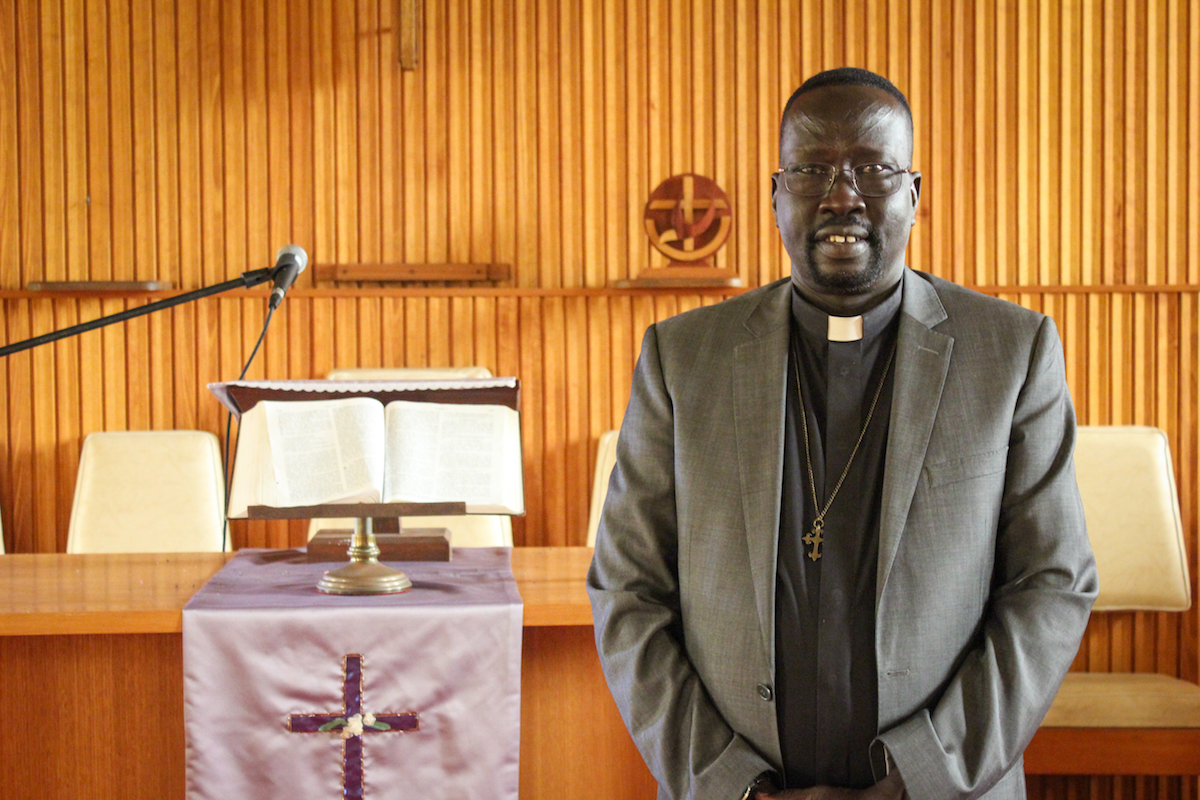
St Andrews Uniting Church minister Rev Nathaniel Atem.
The day before he’d said goodbye to his wife and son. His 17-year-old son begged him to come with them, saying “we can’t leave you here”, but Nathaniel was resolute. He said, “this is my work, whatever happens, I have to remain here”.
Nathaniel has been the minister at St Andrews Uniting Church in Orbost for the past four years. It’s his first placement and it’s certainly one he won’t forget.
He hadn’t experienced bushfire before. Hadn’t heard police tell whole towns to leave, to abandon ship, to get out before it’s too late. Perhaps that’s why he stayed, but no, he’s experienced danger before, he knows it well. He is staying for his people, for his God, he’s staying because it’s what he was called to do.
That unforgettable night on the oval, God was at work. Denominations were irrelevant. Nathaniel and Orbost’s three other Christian leaders worked together, handing out food and water, giving pastoral care, praying.
“All we could do was pray really,” Nathaniel says. “When things like that happen, people come close to God more than ever.”
Then, abruptly, it was gone, the wind had changed. One minute the fire was only 5km away, the next it was off hurtling towards somewhere else. Orbost was safe. Those prayers were answered.
Almost a year on, Orbost looks normal. There are no burnt houses, no burnt trees, everything was left untouched. But of course, things aren’t normal. COVID-19 made sure of that.
Nathaniel says it’s been difficult to not be able to visit people or have in-person services. Within his elderly congregation, some don’t have internet access so Zoom and email only go so far. But those people haven’t felt left out, they’ve heard every Sunday sermon and seen every order of service.
Every Sunday, Nathaniel goes door to door, to the 12 houses without internet, delivering his sermon and handing out printed orders of service. “They are happy to have that,” he says. “It’s a way to stay connected”.
But still, Nathaniel has missed his church. “It’s been so long and we don’t know when we can all go back,” he says. “Though we stay connected as a church, it’s still not the same.”
But it will take more than a major fire and global pandemic to knock Nathaniel down. He is as bright as ever. He chooses to see the positives, summing up this year as a “learning year”.
“We learn through challenges,” he says. “I’ve found God’s richness through online services and finding other ways of practical ministry. The most important thing is to trust God, we just have to have faith.”
MALLACOOTA
The drive from Orbost to Mallacoota is hard to describe in words. The extent of the devastation is impossible to grasp. For 90 minutes, the scenery is that of another world. Its worldly comparison exists only within a dystopian film.
A constant itch to pull the car over and take more photos, even after the camera roll surpasses 50 images of the same sparse landscape, is hard to ignore. Every bend in the road adds a new level to the unshakeable feeling of shock.
The GPS counts down the kilometres left until the town of Mallacoota begins. With just 1.5km left, all that surrounds are charred, black trees. In that moment, it becomes clear how much of a close-call this fire was for this town and its people.
What’s even more shocking is this is 11 months on. If it looks like this now, what on earth did it look like then? It’s unfathomable. The line “you just had to be there” has never felt more relevant.
Entering the town is at first a relief – something remains, some things survived. But looking closer, there are spots of black trees in amongst suburban houses and some road signs look just a little too new. It’s confusing, how did the tree go up, but not the house? Why did the school’s chook shed burn, but not the school? Why that tree and not the other tree?
Rev Jude Benton, Priest-in-Charge of the co-operating Anglican-Uniting Parish of Croajingolong, has an answer. “I’ve heard bushfire described as ‘the claws of a dragon’, some things remain and some things don’t,” she says. Bushfire is random in its choice of victim.
A drive around the suburbs between Bastion Point and Betka Beach prove Jude’s point. On just one street, an empty patch of land sits next door to an untouched house. Across the road another empty lot is nestled between two healthy houses. One lonely swing-set sits on an otherwise empty lot.
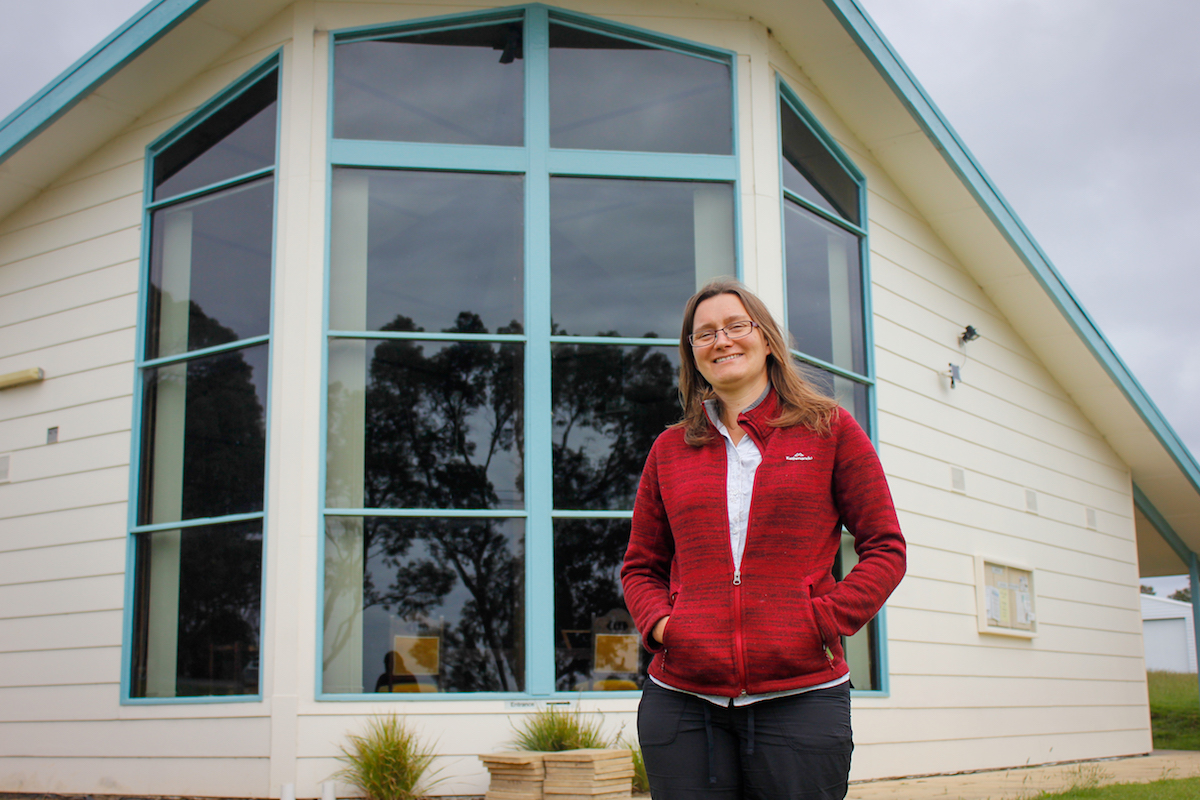
Rev Jude Benton, Priest-in-Charge of the co-operating Anglican-Uniting Parish of Croajingolong.
This area of Mallacoota, what’s been termed the “disaster triangle”, is one Jude, 37, knows all too well. She lives there. About 50 per cent of the houses within this triangle burnt down, Jude explains.
“Everything that remains, remains because someone stayed to protect or you got lucky,” she says.
For Jude and her husband, Andy, it was both. Their neighbour stayed to protect his house and, as luck would have it, his rooftop sprinkler, saved Jude’s house along with his. The fire took their garage and back fences, but stopped just one metre from their back door.
“We certainly didn’t expect to come back to a house,” Jude says.
The fire in Mallacoota was arguably one of the worst within Victoria. Out of 405 houses lost in the state, 123 were lost here. But for locals, it wasn’t a surprise.
“It was obvious it was going to burn, there was so much bush right up to the road and it was so dry,” Jude says. “As soon as the fire started at Wingan Inlet, the locals saw that and went ‘this is it’. It’s exactly what they told us would happen, exactly the same starting place.”
What was a surprise however, was how many tourists refused to abandon their holidays and evacuate.
“There were people who said ‘I’ve just got here and don’t want to go, it’s going to ruin my holiday, are you sure the fire is going to come?’,” Jude says.
The morning after the CFA urged everyone to evacuate, the road to Melbourne was open for two hours. Jude expected there would be an endless train of people leaving, but there wasn’t. Then the road was shut and wouldn’t be open again for six weeks.
What’s even more difficult to comprehend was while people were being told to leave, others were still arriving. A fire-danger map released by East Gippsland Shire Council neglected to include Mallacoota, instead cutting off at Cann River, one hour away.
“That was a huge mistake,” Jude says. “People in their city-centred minds went ‘Mallacoota is safe even if Cann River is not’, so they chose to come here. The map should have shown Mallacoota because the fire danger was worse here.”
For Jude, evacuation was never an option. “This was my job and this was my opportunity to serve the community, there wasn’t a choice in my mind,” she says.
“It would have been different if we’d had young children or if we were elderly or had health conditions.”
Instead, Jude and her husband made the decision to jump on their boat and wait it out in the middle of the lake along with 35 other boats. They ended up spending 36 hours out there with only dried crackers, fruitcake and a cat. In the chaos, they’d left their food bag in the church. The next time Jude saw proper food, she cried tears of joy.
Stepping foot on solid land might’ve been a relief, but the mayhem was only beginning to ramp up. The impact of fire doesn’t end after the flames go out. It’s a long, long journey.
But for two reasons, the immediate response in Mallacoota was more problematic than it needed to be. Number one – “no one was obviously in charge,” Jude says. Number two – tourists.
“Only a month before the fire, I had told my friend, ‘we will be OK if the fire comes before the tourists get here and we will be OK if the fire comes after they leave, but we won’t be OK if it comes while they are here,” she says. “And that was exactly what happened.
“You suddenly had 5000 tourists who had refused to evacuate now demanding to be evacuated. Then you’ve got locals going, ‘my house just burnt down’.”
One suggestion that’s been made since is to have two separate response centres – “one for tourists to talk about how to get evacuated and one for locals to go ‘I just lost my house and I need some clean undies’,” Jude says.
People sent aid, boxes of food come flooding in. It’s a nice thought but Jude says “most of it honestly should’ve been sent straight back”.
“It was diabolical, whole pallets of liquorice bullets and Skittles, jars of tuna and liver pate,” she says. “Where’s the vegetables, where’s the real food?”
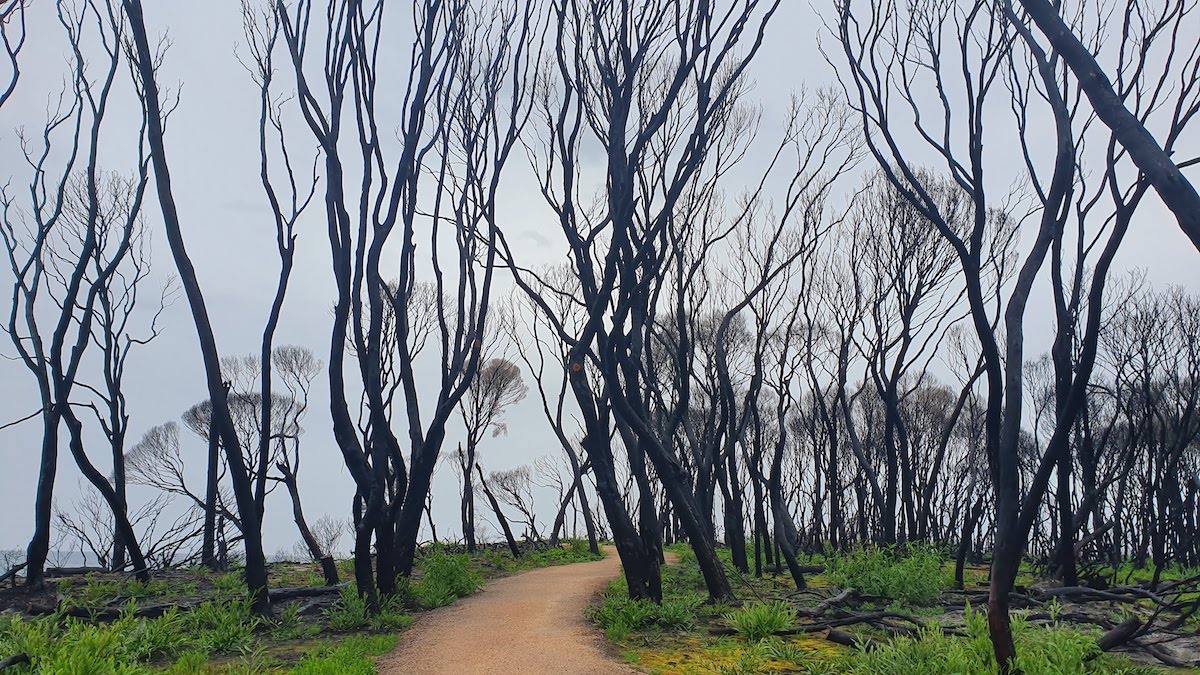
The path to Mallacoota’s Betka Beach.
With aid comes decisions – who deserves it most? It there a hierarchy of people in need? And without any person in charge, arguments inevitably arise.
“Is it only for the people who lost houses or is it for anyone in need? Where do you define who calls the shots on that?” Jude says.
“None of us have done disaster before, we are all making it up and the professionals who come, come in for four-day rotations and leave again.”
One professional who did come with sound advice was disaster psychologist Dr Rob Gordon. Throughout various community seminars, he told locals “your task for the next year is to gather as community, to retell, to reaffirm to each other that we’ve survived and we’re going to stronger as a community,” Jude says.
“In community, people who lost their houses can learn from what each other is doing and you can make sure people aren’t falling through the social net.”
But then COVID-19 happened. Community became an occasional run-in at the local supermarket and meetings went online. And in a town where the NBN infrastructure was burnt and broadband companies won’t put in any more ADSL because “NBN is coming”, online isn’t an easy space.
“Everything is done via a mobile hotspot, which isn’t really good enough for video calls,” Jude says. “There are frequent power cuts, the internet can just drop out for no reason for a day or more.
“On top of that, phone reception is scattered. These are things that don’t look like bushfire recovery but they are.”
One major bushfire recovery obstacle may seem obvious, but is by no means simple. With 123 houses gone, the challenge becomes finding these people somewhere to live. Insurance might cover their rent, but first they need somewhere to rent.
“The majority of those houses were either owner-occupied or long-term rentals, they weren’t holiday homes, so then you’ve got perhaps 100 households who need somewhere to live,” Jude says.
“Before the fire hit, there were barely any rentals available, now there’s none. While those who lost their houses were looking for places to stay, so were the red cross, or social workers, or the clean-up crew from Grocon. They all needed accommodation, too.
“People have moved into holiday rental accommodation and some of the holiday homeowners rubbed their hands with glee and went ‘my tiny unit is $1000 a week’, and most people’s insurance policy will pay that.”
With summer holidays coming up again and travel restrictions easing, those in holiday rentals are uncertain whether they’ll be kicked out so tourists can be brought in. And many haven’t been able to rebuild so have nowhere else to go.
“We have people who thought they would have rebuilt by now, but the process is actually quite traumatic, people don’t have the energy to make those decisions right now.
“Some people weren’t allowed to rebuild because they didn’t get a high enough Bushfire Attack Rating (BAL Rating).
“So far I think only one family is in their rebuilt house, about five others are in varying stages of completion.”
The government had a solution to this problem, it just hasn’t arrived yet. They promised short-term modular housing for up to three years, which is supposed to sit on your land while you rebuild. But this hasn’t made its way to Mallacoota yet. Apparently, it’s “coming soon”, Jude says.
But this solution isn’t without its own issues. For those with smaller blocks, it simply isn’t viable. They can’t fit the modular housing unit on their property and rebuild at the same time.
“Housing is just such a huge issue,” Jude says.
On top of the search for housing, locals have been through the extreme fear of the fire, the chaos of its aftermath and then COVID-19’s enforced isolation. Unsurprisingly, it’s all taken a toll on people’s mental health.

Jude and her husband Andy didn’t expect to come back to a house.
And when in-person gathering was restricted in late March, all the agencies who Jude says had “promised a year of ongoing pastoral care” went back to the city. And as the leader of the only church in town, a lot of that responsibility fell to Jude.
“During the first lockdown, I was literally the only person left on the ground doing face to face stuff with people,” Jude says. “I was doing it at the op shop or wherever I could.”
The first few months of 2020 were non-stop for Jude, so much so it is still a little blurry in her memory. On top of caring for others she was dealing with her own trauma. But she kept giving and giving until, thankfully, Mallacoota got a coordinator at the local bushfire hub.
“She was fantastic, suddenly there was somebody being in the focal point of making sure people were getting the support they needed,” Jude says.
“The Royal Flying Doctors services offered 10 free psychologist appointments for bushfire affected areas so people started to become much more aware of the mental health impact.
“For my own coping, I had to stop doing as much pastoral care as I had been doing because you just can’t do it all yourself.
“Everybody in this community, including myself, is struggling with trauma. You just can’t keep giving at that level.
“It’s been the hardest year of my life without a doubt.”
They say diamonds are made under pressure. Well, Jude has certainly experienced an incredible amount of pressure and, while she is too humble to call herself a diamond, she’s certainly learnt a great deal this year.
“I’ve learned to take advantage of the different things,” she says. “To book in with the psychologists, because they’re the experts on this stuff.
“It’s taught me the importance of boundaries. To try to give myself permission, to take it easy and to take days off. To actually switch my phone off on a Sunday afternoon and not turn it back on until Tuesday morning. To be able to say ‘I’m at capacity, I can’t’. To try and identify which hat I wear at which time, am I wearing the ‘priest’ hat? Or the ‘bushfire recovery’ hat? Or am I wearing the ‘this is just Jude having some time for herself’ hat?”
“It’s been such a frustrating year, so learning to let go of what I can’t control has been really important.”
Having church life put on hold due to COVID-19 has been a major source of frustration, especially given Jude hasn’t heard of any local positive cases, the nearest being in Bairnsdale almost three hours away.
“We should have been allowed to come together as a community while the roads were shut and no one was allowed to travel,” Jude says. “It was safe in Mallacoota.
“It’s been detrimental to not be able to maintain our routines of faith and community and as a leader, I’ve found it very hard to abide by and promote rules when they no longer make sense to me.
“We’ve been able to have the caravan park open and people coming from anywhere in regional Victoria sharing toilet and kitchen facilities, we can open our op shop, but we weren’t able to have people worship in the church.”
Although COVID-19 put a stop to in-person church services, the fire in a strange way breathed new life into the church. Jude herself was voted on to the Mallacoota and Districts Recovery Association committee, which she says “is a sign that the community is responding to the church and my work”.
“We’re not like most towns, where the church is somewhere central in town, we are off to the side,” she says. “And I think that’s how the community has always regarded the church, ‘it stays off to the side’.
“But this year has given me the opportunity to meet with people in a very different way, I could have stuck with being just the church minister, that might’ve actually been easier, but I don’t think it would’ve been the right thing to do.
“The community has embraced me and my ministry in a way that I never would have expected.”
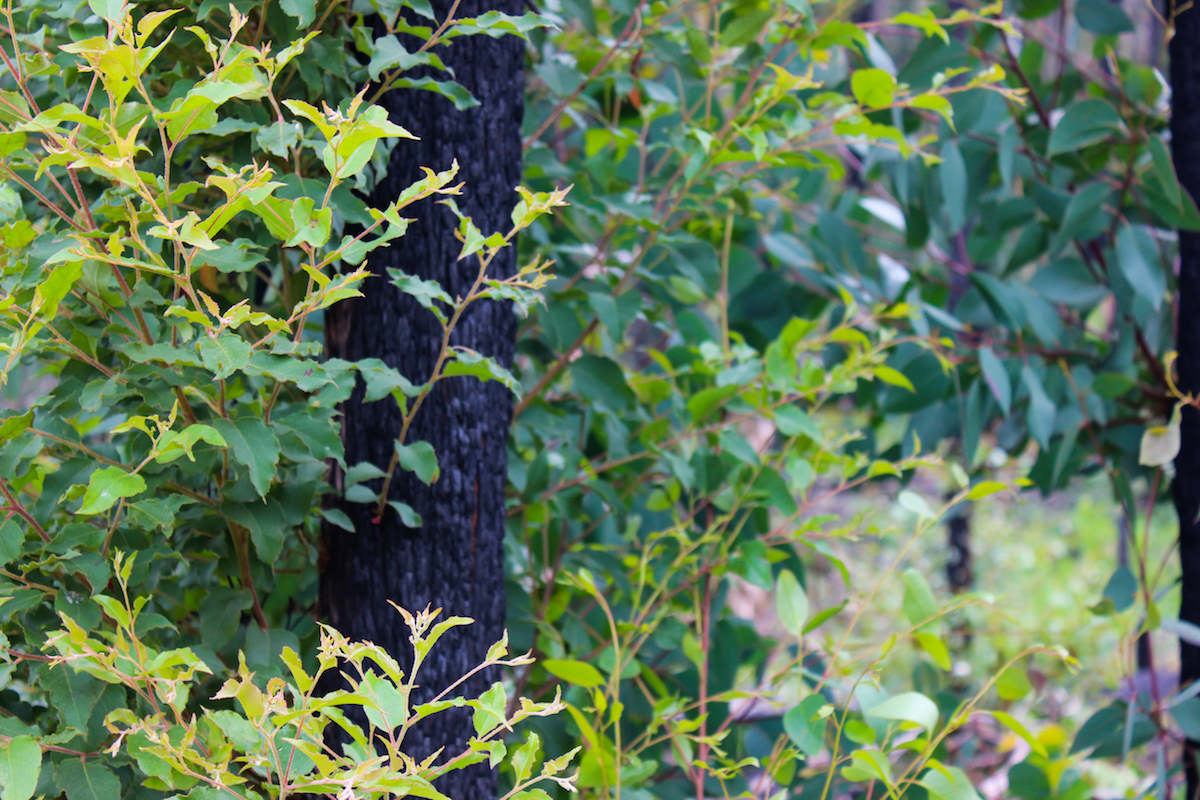
“The community has embraced me and my ministry in a way that I never would have expected,” Jude says.
Life is full of ups and downs. And while this year, for many, will be remembered as one of immense darkness, that’s not to say it’s been without light.
The light has shone differently on each person. For Rachel, it was the care and support she experienced from her community. For Nathaniel, the potential of prayer and innovation. For Jude, it’s the knowledge that her community, Christian or not, is embracing and respecting her ministry more than ever.
It has, as Nathaniel says, been a year of learning. We’ve learned to be grateful for the little things – a bed in a room above a pub, a change of wind, internet connection.
We’ve learned that geography isn’t a barrier to connection, but to be grateful when given the opportunity to sit physically beside someone.
Jennie says the power of presence has been a more “embodied learning” this year.
“Being beside people without an agenda, giving them space to talk, just to be present without feeling like you have the answers or something special to give them,” she says.
It’s been a year of unknowns. How many people can visit my house? When can I go back to work? Will we be allowed to have Christmas with our families?
But some things we know for certain. We know that trees grow back and flowers return each spring. We know what was once scorched will again be green. It’s happening already, slowly but surely. And like mother nature, these communities will also regrow. Houses will be rebuilt, communities will be reunited and economies will see better days.
This year won’t be forgotten anytime soon and, for many, its impacts will last a lifetime. But there will be a next year and a year after that, each bringing their own times of chaos and times of joy.


